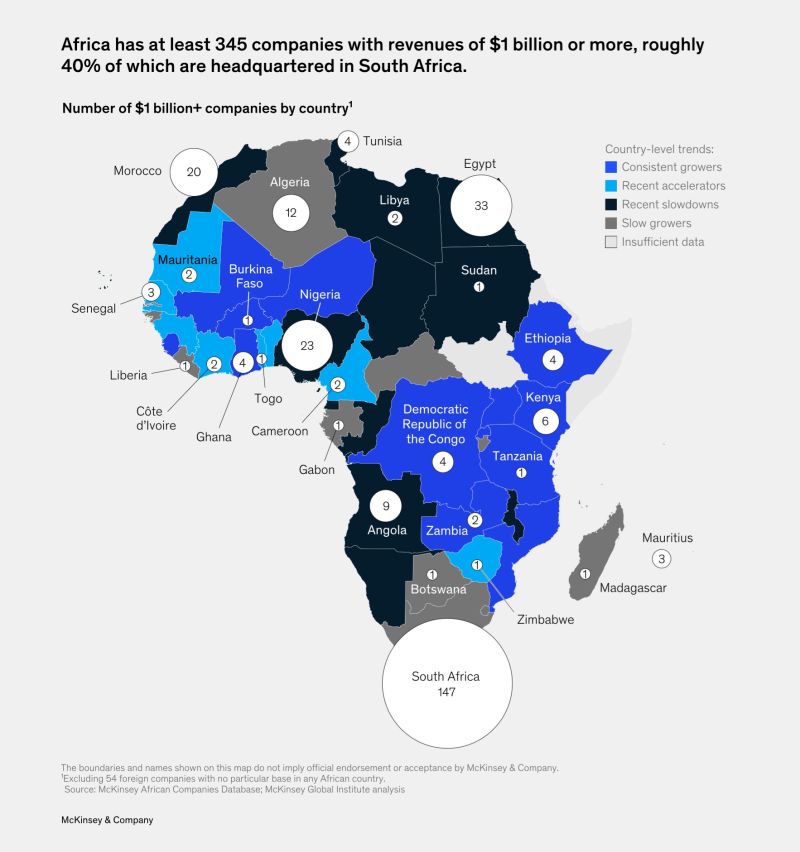-
AuteurBerichten
-
-
Africa’s Economic
Renaissance: The
Rise of Homegrown
Billion-Dollar
Companies.

Abstract:
Africa’s economic growth has demonstrated resilience and dynamism, reflected by the existence of at least 345 companies generating annual revenues of $1 billion or more. This paper explores the factors contributing to the growth of these enterprises, the sectors driving revenue generation, and the potential for further expansion across the continent. Additionally, it examines the geographic distribution of these companies and assesses the implications of a concentrated corporate footprint, particularly in South Africa. Through a lens of sustainable development and regional integration, this article provides insights into Africa’s limitless growth potential.
Introduction.
The narrative of Africa’s economic landscape has shifted significantly in recent decades. Beyond traditional resource extraction, a wave of large enterprises has emerged, contributing over $1 trillion in collective revenue. Of these, 230 companies are homegrown, founded by local entrepreneurs, while 52 are state-owned enterprises. This paper investigates the composition, regional distribution, and sectoral representation of these firms.
The Role of Homegrown Enterprises.
Homegrown enterprises account for two-thirds of Africa’s billion-dollar companies. These organizations, often established by visionary local entrepreneurs, exemplify the continent’s innovation and resilience. They operate across diverse sectors, including oil and gas, mining, retail, consumer goods, financial services, manufacturing, and telecommunications. The success of these companies underscores the importance of fostering entrepreneurship and creating an enabling environment for business growth.
Sectoral Dominance and Revenue Generation.
Approximately 70% of the revenue generated by Africa’s large companies originates from six key subsectors:
- Oil and Gas: Energy resources continue to be a significant contributor to the continent’s economy.
- Mining: Resource extraction remains a major revenue driver.
- Retail and Consumer Goods: A growing middle class fuels domestic consumption.
- Financial Services: Expanding financial inclusion and digital banking innovations bolster sector growth.
- Manufacturing: Industrialization initiatives support job creation and value addition.
- Telecommunications: Increased mobile and internet penetration facilitates connectivity and business expansion.
Geographical Concentration.
South Africa stands out as a hub for large corporations, hosting 40% of Africa’s billion-dollar companies. With 147 headquartered there, the country leverages a well-developed financial sector, infrastructure, and regulatory framework. Notably, 118 of these firms are locally established, while the rest are foreign-owned. This concentration signals both the strengths and challenges of regional economic imbalances. Expanding corporate presence across other African countries presents an opportunity for inclusive growth.
Policy Implications and the Role of AfCFTA.
The African Continental Free Trade Area (AfCFTA) aims to eliminate trade barriers, enhance intra-African trade, and promote industrialization. By creating a single market of 1.4 billion people, AfCFTA provides a platform for companies to scale operations, access new markets, and strengthen supply chains. Policymakers must facilitate cross-border investments, enhance infrastructure, and support small and medium enterprises (SMEs) to ensure equitable growth.
Conclusion.
Africa’s economic potential remains vast, driven by resilient local entrepreneurship and strategic policy frameworks. The rise of billion-dollar companies across various sectors highlights the continent’s capacity for sustained growth. By expanding corporate footprints, leveraging AfCFTA’s opportunities, and fostering regional cooperation, Africa can further solidify its position as a global economic powerhouse.
References
- McKinsey & Company. (2025). Africa’s Rising Billion-Dollar Companies Report.
- African Union. (2024). AfCFTA Progress Report.
- World Bank. (2025). Economic Outlook for Sub-Saharan Africa.
-
-
AuteurBerichten
Je moet ingelogd zijn om op dit onderwerp te kunnen reageren.









